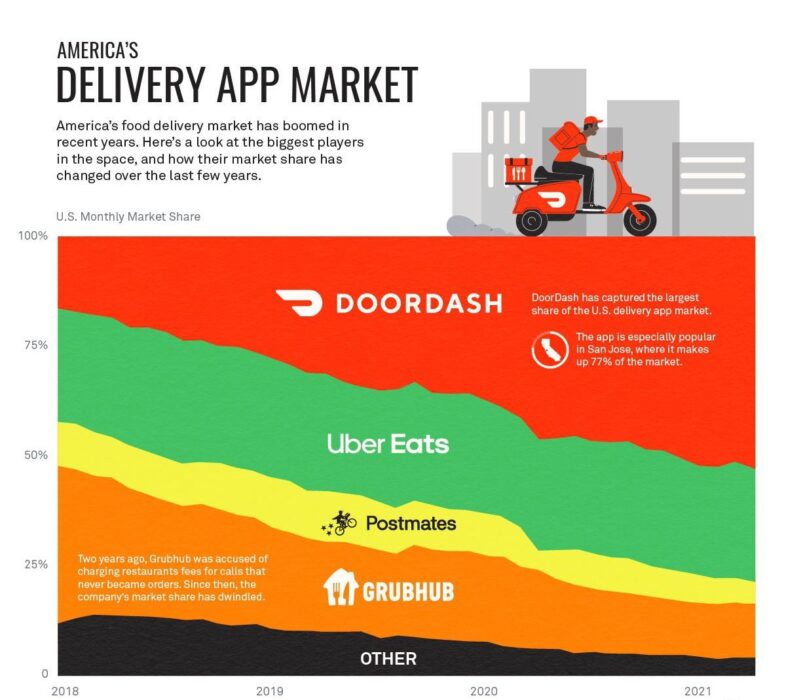DoorDash has revolutionized the delivery service landscape, becoming a household name in just a few years. What started as a small startup has now grown into the dominant player in the U.S. delivery app market. But how did they achieve such a meteoric rise? Let’s explore the journey of DoorDash, uncovering the strategies and innovations that propelled their success.
The Humble Beginnings of DoorDash
Every successful company has its origins, and DoorDash is no exception. Founded in 2013 by Tony Xu, Stanley Tang, Andy Fang, and Evan Moore, the company began with a simple mission: to help local businesses thrive in the digital age. The first version of DoorDash launched in Palo Alto, California, and faced initial challenges such as logistical hurdles and building a reliable delivery network. Despite these obstacles, their determination and vision set the foundation for future success .
Innovative Business Model and Strategy
DoorDash’s success is rooted in its innovative business model. By connecting customers with their favorite local restaurants through an easy-to-use app, DoorDash created a seamless on-demand delivery service. They formed strategic partnerships with a vast network of restaurants, offering them a platform to reach more customers. Utilizing cutting-edge technology, DoorDash optimized delivery routes, ensuring fast and efficient service . This focus on convenience and reliability quickly won over customers.
Key Strategies Behind DoorDash’s Dominance
DoorDash pulled off one of the most underappreciated market share robberies of all time. In just three years, they exploded from 16% to 53% share of the U.S. delivery app market. Here are four strategies they used to crush Uber Eats, GrubHub, and Postmates:
- Avoiding the Competition: DoorDash targeted restaurants without delivery services, often with pre-existing customer bases, rather than competing for newer restaurants with multiple other providers .
- Empowering Restaurants: DoorDash acquired restaurants by providing them with not just delivery services, but insights they never had before: popular dishes in the area, customer demographics, local delivery times, and more .
- Maximizing AOV: DoorDash focused on winning outer suburbs with large family homes—an underserved segment with a much higher average-order-value (AOV) than urban regions .
- Brand Positioning: When COVID-19 hit, DoorDash supported its Dashers and restaurants by offering payment advances and other benefits, creating significant supply growth for their marketplace .
DoorDash saw the opportunity, developed a plan… and they delivered.
Expansion and Acquisitions
From its modest beginnings, DoorDash rapidly expanded to new cities, capturing a significant share of the market. Their growth strategy included acquiring competitors like Caviar, which bolstered their presence and service offerings . With substantial funding from investors, DoorDash was able to scale operations, invest in technology, and enhance their service capabilities. Their relentless pursuit of excellence propelled them to the forefront of the delivery industry .
Impact on the Delivery Industry
DoorDash didn’t just grow; they revolutionized the delivery industry. By offering an extensive selection of restaurants and efficient service, they set new standards for competitors. Their influence spurred innovation across the sector, leading to better services for consumers. For local businesses, DoorDash provided a valuable lifeline, enabling them to reach new customers and increase sales, particularly during challenging times like the COVID-19 pandemic .
Adapting to Market Changes
The COVID-19 pandemic presented unprecedented challenges, but DoorDash adapted swiftly. They introduced contactless delivery options and expanded into grocery and convenience store deliveries, catering to the changing needs of consumers . These adaptations not only helped them survive but thrive during the pandemic. Looking ahead, DoorDash is focused on sustainability and exploring new markets, ensuring they remain a leader in the industry.
Conclusion
The success story of DoorDash is a testament to innovation, resilience, and strategic execution. From their early days to becoming an industry leader, DoorDash has continually evolved to meet market demands. Their journey offers valuable lessons in adaptability and customer-centric thinking, making them a shining example in the world of business.
FAQs
- How did DoorDash start?
- DoorDash was founded in 2013 by Tony Xu, Stanley Tang, Andy Fang, and Evan Moore with the aim of helping local businesses thrive through efficient delivery services.
- What makes DoorDash different from other delivery services?
- DoorDash stands out due to its vast network of restaurant partnerships, user-friendly technology, and commitment to fast, reliable service.
- How has DoorDash impacted local restaurants?
- DoorDash has provided local restaurants with a platform to reach more customers, increasing their sales and helping them survive, especially during difficult times like the pandemic.
- What challenges did DoorDash face during the pandemic?
- DoorDash had to quickly adapt to changing consumer needs by introducing contactless delivery and expanding into grocery and convenience store deliveries.
- What are DoorDash’s future plans?
- DoorDash is focused on sustainability, exploring new markets, and continuing to innovate to meet evolving consumer demands.


Leave a Reply